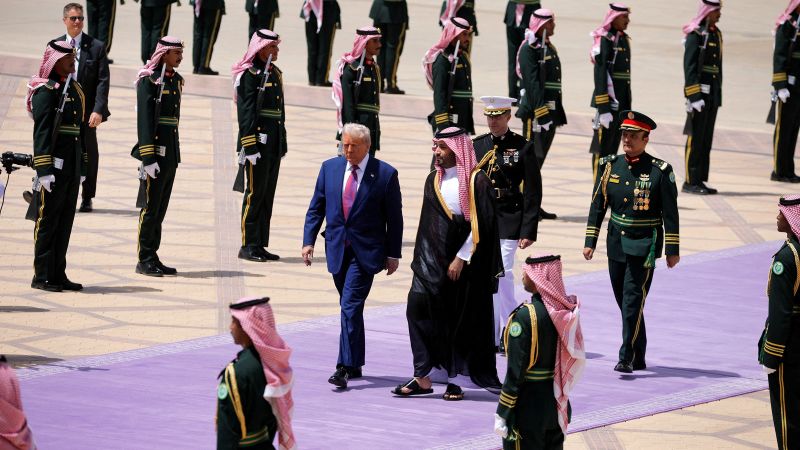In a significant diplomatic event that marked the beginning of President Donald Trump’s second term, the leader arrived in Riyadh, Saudi Arabia, on a grand note. The occasion was adorned with a royal-purple-carpet welcome and a motorcade procession flanked by an impressive cavalry of Arabian horses. This ceremony not only highlighted Saudi Arabia’s hospitality but also set the stage for a day of high-stakes discussions and international negotiations focused on enhancing ties between the United States and the Gulf nation.
At the center of this meeting were prominent business leaders from the tech sector and high-ranking Saudi officials. President Trump presented himself as an adept dealmaker ready to forge new alliances and drive economic growth in the region. During his address, he articulated a lofty vision aimed at achieving peace and prosperity that reverberated through the halls of the Royal Court. The president unveiled multiple investment deals and controversially announced a decision to lift sanctions on Syria, signaling a potentially transformative shift in U.S. foreign policy after years of stringent measures.
Trump made an appeal for Saudi Arabia to join in the Abraham Accords—agreements finalized during his first presidency that aimed to normalize relations between Israel and its Arab neighbors, notably the UAE and Bahrain. The president utilized this visit to pressure Iran into negotiations regarding its nuclear aspirations, demonstrating his commitment to reshaping the geopolitical landscape of the Middle East.
However, the backdrop to Trump’s grand vision is fraught with complexity. The ongoing and volatile conflict in Gaza severely constrained his capacity to exert influence in the region. This conflict introduces considerable challenges to any attempts to stabilize or redefine relationships, making it evident that the road ahead is riddled with obstacles.
In an atmosphere charged with anticipation, Trump outlined his emerging foreign policy ideals, captivating both allies and adversaries alike. During his remarks at the Saudi-US Investment Forum, he remarked, “I’m different than a lot of people think. I don’t like permanent enemies, but sometimes, you need enemies to do the job and you have to do it right. Enemies get you motivated,” suggesting a complex and perhaps Machiavellian approach to international relations.
The event was significant not only for diplomatic reasons but also for the theatrical presentation it carried. Trump, a figure adept at understanding media imagery, was met with a 21-gun salute upon his descent from Air Force One, and he engaged in intensive discussions with Crown Prince Mohammed bin Salman, further solidifying the ties between the U.S. and Saudi Arabia. The luncheon featuring top executives from tech giants like Amazon, Uber, and Nvidia displayed the importance placed on fostering relationships between governments and corporations.
Trump’s remarks echoed a commitment to a collaborative future, stating that the bonds he shares with the crown prince would be “closer, stronger and more powerful” than ever. This rhetoric was a clear departure from the approach taken by former President Joe Biden, who had previously referred to Saudi Arabia as a “pariah” following the controversial murder of journalist Jamal Khashoggi. Remarkably, this issue was conspicuously absent from the discussions during Trump’s visit, which underscored a stark political pivot in U.S.-Saudi relations.
In a particularly controversial announcement, Trump divulged plans to lift sanctions on Syria, an action influenced by dialogues with both Crown Prince Mohammed bin Salman and Turkish President Recep Tayyip Erdogan. Trump justified this decision by stating that while the sanctions had played a critical role in international relations, it was now time for Syria to demonstrate progress. Dismissing potential criticisms, he expressed optimism about the future of Syria, inviting it to “show us something very special.”
As discussions turned to the topic of the Abraham Accords, Trump expressed his fervent hope for Saudi Arabia to normalize relations with Israel, while recognizing the crown prince’s stance requiring a resolution to the Palestinian issue. This acknowledgment pointed to the complex negotiations and conditionality that define Middle Eastern politics, particularly with ongoing hostilities in Gaza.
Trump’s repeated calls for peace in Gaza highlighted the dire humanitarian conditions within the enclave, where the lives of civilians have been marred by relentless conflict. His earlier blunt proposals for the region, including resettlement ideas, bring forth a stark picture of U.S. aspirations for the Middle East.
The journey to redefine U.S.-Saudi relations and Middle Eastern diplomacy has just commenced, with Trump’s visit drawing attention to the intricacies of foreign engagement in a region characterized by longstanding tensions and emerging alliances. This visit serves as a reminder of the dramatic political shifts and business negotiations that can shape international landscapes, opening new dialogues and extending the narrative of U.S. involvement in the Middle East.



